Contents
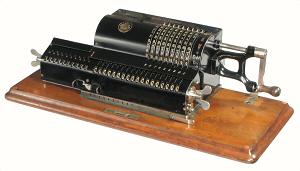
Contents |

|
| Brunsviga Model A, c.1898 |

The "pin-wheel" from which these calculators take their name is a circular disc or wheel which has nine retractable pins extending radially around part of its circumference. The pins can be extended or retracted by a setting mechanism, which is generally operated by rotary levers. The pin-wheels and setting rings are assembled into a "rotor" or cylinder, which rotates forward or backward as the handle is turned. The extended pins act as gear teeth to advance a register by the corresponding number of places. The wheel in the illustration shows five pins extended on the left-hand side. (The two pins on the right are part of the tens-carry mechanism).
The concept of a variable-toothed gear was known to Leibnitz in the 1600s. An early form of pinwheel was used in machines such as the cylindrical Roth calculator from 1841, but these machines were never produced in quantity. The modern form of the pin-wheel calculator dates from the early 1870s, when similar machines were developed more or less simultaneously by Frank Baldwin in America and Willgodt Odhner, a Swede living in Russia.
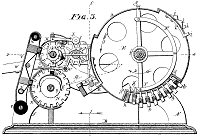
Baldwin's machine was developed during 1872 and 73, and was sold and used commercially from 1874. It is generally acknowledged as the first practical pinwheel calculator, although it is often called the "Baldwin 1875" machine after the year in which it was granted its US Patent (No. 159244). The illustration (from the patent drawings) shows a cross-section of the machine, with the setting lever at the top and the pins extended at the lower right. The arrangement at the left-hand side is a printing mechanism to take an impression of the raised numerals on the register wheels. Baldwin was a prolific inventor who continued to develop many and varied calculator mechanisms (including that for the Monroe line) until his death at 87 in 1925.
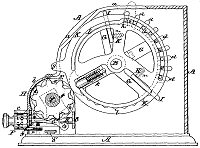
Odhner's machine was developed in St. Petersburg from about 1874. This illustration from his US Patent (No. 209416) of 1878 shows a pinned disk and setting mechanism that is directly comparable to the modern version shown above. Odhner's design had the greater commercial success, and it was his name that became more generally associated with the pinwheel mechanism. By about 1890 (US Patent 514725) the Odhner calculator had developed into the form which was to endure more or less unchanged for the next eighty years. In 1892 the patent rights were sold to a firm in Germany, who developed a very successful line of machines under the name "Brunsviga". Similar machines soon appeared from many other manufacturers. After the Russian revolution in 1917, Odhner's heirs re-established the company in Goteborg, Sweden, under the brand name "Original-Odhner".
The pin-wheel calculator was a simple and reliable machine, which was capable of all four arithmetic functions. Addition and subtraction were performed directly, while multiplication and division were accomplished by simple procedures involving repeated additions (or subtractions) and carriage shifts.
Options and additions to the basic mechanism included:
Pinwheel machines to Odhner's basic design were in continuous production for almost one hundred years, from their beginnings in the 1870s until overtaken by four-function electronic calculators in the 1970s. The machines were built (and copied, legally or otherwise) in many countries of the world. Those found in Australia were generally built in Europe, but not all European brands were represented here.
Follow these links to separate pages describing the pin-wheel calculators most frequently found in Australia, or read on for some less common machines from countries around the world.
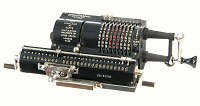 Britannic Model 2A, S/N 8309
Britannic Model 2A, S/N 8309
Digits: 9 rotor, 10 counter, 18 accumulator
Dimensions: Body 145W x 100D x 90H, overall width 310mm
Weight: 3.8 kg
Manufactured: London, England.
The Britannic Model 2A is a small and simple pinwheel calculator which was made in England by Guy's Calculating Machines of Wood Green, London. The body of the machine is built from three brass castings with sheet-metal top covers. Although the calculator itself is in very good condition, it is missing its original wooden base and cover.
The rotor pinwheels are 48mm in diameter, with the setting rings spaced on 6.0mm centres (ie, the mechanism is built to metric dimensions). A rotor clearing lever is provided on the face of the machine, to the left of the setting rings.
The carriage has an 18-digit accumulator, with tens-carry extending to 13 places. There is no tens-carry on the counter register. The carriage shift mechanism has a sliding bar which moves one place at a time in either direction, and a lever to allow continuous movement.
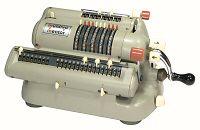 Muldivo Mentor (Walther WSR-160), S/N 224279
Muldivo Mentor (Walther WSR-160), S/N 224279
Digits: 10 rotor, 8 counter, 16 accumulator
Dimensions: Body 240W x 160D x 135H, overall width 330mm
Weight: 4.6 kg
Manufactured: Walther, Germany, 1950s and 60s
The Muldivo Calculating Machine Company was established in London in 1912. The company distributed the British-made Britannic machine (above), and acted as importers and agents for several European manufacturers. The "Muldivo Mentor" is a re-badged (post-war) machine from the Walther company in Germany. The Muldivo nameplate simply states "Foreign manufacture", but retains the Walther WSR-160 model number. Further details are available on the Walther page.
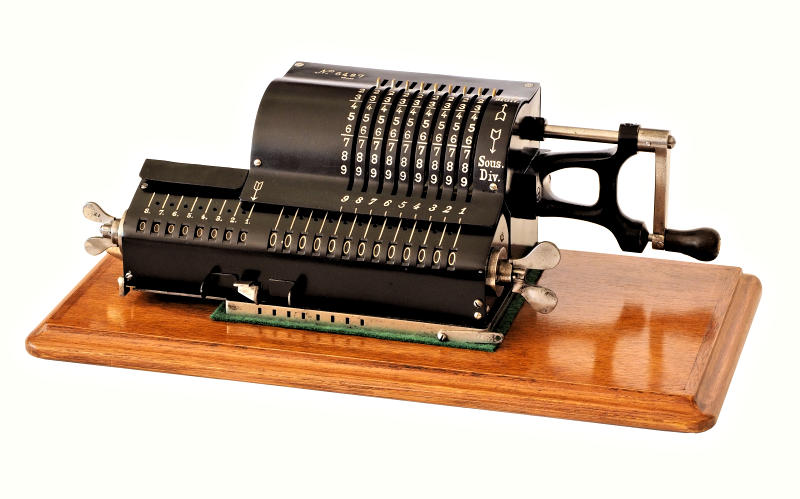 Dactyle (Chateau), S/N 6487
Dactyle (Chateau), S/N 6487
Digits: 9 rotor, 8 counter, 13 accumulator
Dimensions: Body 155W x 140D x 120H, base board 410 x 210mm
Weight: 7.81 kg
Manufactured: for Chateau Bros, Paris, c.1897-1929.
The Dactyle calculators were built in the traditional clock-making district of Jura in the French alps. They were distributed by the Chateau Brothers of Paris, with overseas agents including Muldivo in England and the Marchant Brothers in the USA. Later versions were also sold under the Chateau name.
The early Dactyle machines bear more than a passing resemblance to the Brunsviga Model B. The Brunsviga machines were manufactured in Germany under licence from Odhner, for sale in Germany and Austria only. It appears that (intially at least) Brunsviga supplied Model B parts for the Chateau Brothers to assemble, so as to provide a "back-door" entry to the French market. Early Dactyles have been found with "Subt" rather than the French "Sous" as the abbreviation for Subtraction, and even with the Brunsviga logo hidden under a Dactyle nameplate. Once local French production became established around 1905 the machines started to diverge as Chateau incorporated many of their own independent developments. Production ended around 1929 with a total of about 13,000 machines sold.
The machine illustrated is a very basic pinwheel calculator from about 1909. It is heavily built of cast iron and brass, with pinwheels 71mm in diameter and 9mm thick. The rotor assembly alone weighs almost 2kg. Although this machine lacks (and has never had) the usual square nameplate on the left-hand side, it is identified by the "Sous" marking for subtraction and the French patent inscription "Bté SGDG" (for "patented without government guarantee") under the serial number and on many of the internal parts.
The Marchant Calculating Machine Company was established in California to manufacture a local version of the Dactyle machine. Please visit the Marchant page for further information.
Internal view.
Serial number and patent notice.
Comparison of Brunsviga B, Dactyle, and Marchant machines.
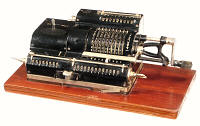 Triumphator, S/N 8252
Triumphator, S/N 8252
Digits: 9 rotor, 8 counter, 13 accumulator
Dimensions: Body 200W x 120D x 120H, overall width 335mm
Weight: 6.7 kg
Manufactured: Triumphator Werk, Leipzig, Germany, c.1914
The Triumphator Works built pinwheel calculators at Leipzig in Germany from 1907. Their machines were very popular in Europe, but are rarely found in Australia. The machine illustrated was built around 1914, and was sold through a dealer in London (presumably just before the outbreak of war).
This well-used machine has a check dial on the rotor and full tens-carry on both registers, but no back-transfer mechanism. The rotor is cleared by lifting the external bail across the front of the setting rings. The registers are cleared by a full turn of the wing nuts at either end. The carriage is positioned manually by pressing the tab at the front and moving it to the desired position.
The extended section at the left of the machine contains the carry rotor and the reversing mechanism for the counter register. The counter is set manually for multiplication or division by the lever at the top left. The machine is very solidly constructed of cast iron and brass, and is mounted on a wooden base with an embossed sheet-metal cover.
Dealer's label on rear panel (29kb).
Triumphator cover (unrestored).
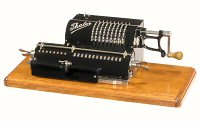 Thales Model A, S/N 9696
Thales Model A, S/N 9696
Digits: 9 rotor, 8 counter, 13 accumulator
Dimensions: Body 130W x 120D x 90H, overall width 290mm
Weight (machine only): 4.5 kg
Manufactured: Thaleswerke GmbH, Rastatt, Germany, c.1920
Emil Schubert (1883-1952) had worked for Triumphator in Leipzig before establishing his own company at Rastatt in Germany. He built the Thales pinwheel calculator in several versions from 1911, and the Tasma add-list machine from 1924.
The Model A is a basic machine in 9x8x13 format. It has no back-transfer or counter carry mechanisms, but does include an interlock between the carriage and rotor positions. This 1920s version has a spring barrel and pull-wire which steps the carriage automatically to the left when the tab at the front is pressed. Simultaneously pressing the small lever at the left-hand end allows the carriage to run fully to the left. It is returned manually by pressing the tab and pushing back on the finger plate at the left-hand end.
The rest of the Thales mechanism is very similar in principle and in detail to the Model A Brunsviga, but scaled to about 2/3 the size.
The machine illustrated was received in very poor condition, and required major internal repairs to the registers and pinwheels. The case and numerals have been repainted, and a new wooden base fitted. The rotor decimal point indicator and quick-clearing bar are still missing.
Rear view showing spring barrel and rotor interlock.
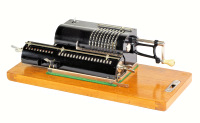 Thales Model B, S/N 9045
Thales Model B, S/N 9045
Digits: 9 rotor, 10 counter, 18 accumulator
Dimensions: Body 160W x 120D x 90H, overall width 350mm
Weight (machine only): 4.9 kg
Manufactured: Thaleswerke GmbH, Rastatt, Germany, c.1920
The Thales Model B is basically the same as the Model A but in an extended 9x10x18 format. This early example has the same rotor interlock as the Model A above, but does not have the spring-loaded carriage mechanism. Every major component of this machine is stamped with (at least) the last two digits of the serial number, and one or more letters identifying the workmen who made it.
The 18-place Model B has the same 9-place rotor as the A, with the carry discs extending only to the 13th place. The internal view shows an auxilliary bell added to the mainshaft to warn when carries extend beyond the rotor capacity. The bell at the end of the carriage operates from the 18th accumulator place in the normal manner.
The machine illustrated was sold through the Muldivo Calculating Machine Company in England. The Thales name has been removed from the outside of the top cover, but remains as a ghostly reverse image on the inside. A Muldivo nameplate is attached to the baseboard.
Thales B in wooden case.
Internal view with auxilliary bell.
Thales name on inside of top cover.
Thales B with Muldivo nameplate.
Muldivo nameplate detail.
 Schubert Model DRV, S/N 137791
Schubert Model DRV, S/N 137791
Digits: 10 rotor, 8 counter, 13 accumulator
Dimensions: Body 210W x 140D x 135H, overall width 330mm
Weight: 5.6 kg
Manufactured: Rastatt, West Germany, 1953-68
Emil Schubert (1883-1952) built the Thales pinwheel calculator (above) at Rastatt in Germany from 1911, and the Tasma add-list machine from 1924. Schubert lost control of the company in the early 1930s, but re-established a new business under his own name in 1938. Production of Schubert calculators resumed after the war, and continued until the late 1960s.
The Schubert Model DRV was first introduced in 1953. This colourful version in metallic green hammertone is from the 1960s. The machine was designed to facilitate one-handed operation, with all of the controls located (or duplicated) on the right-hand side.
The rotor has ten setting rings on 7mm centres, with a check dial above and a quick-clearing lever to the right.
The carriage has separate clearing levers for each register. The right-hand lever normally clears both, but the coupling can be disconnected by pressing the small tab between the registers. The carriage shift levers at the front are replicated in the double-sided lever below the winding handle.
The counter register has full tens transfer, with automatic reversing and manual override. The carry mechanism is unusual, in that it uses a simple odometer-style register with a powered "helper" mechanism to assist each dial over its detent.
The machine has a back-transfer mechanism operated by the handle at the right-hand rear. The rotor clearing lever is pushed rearwards and held, then back-transfer lever is pulled forward and latches. The result is transferred as the accumulator is cleared.
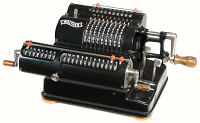 Walther Model RMKZ, S/N 21917
Walther Model RMKZ, S/N 21917
Digits: 10 rotor, 8 counter, 13 accumulator
Dimensions: Body 185W x 130D x 135H, overall width 300mm
Weight: 3.6 kg
Manufactured: Zella-Mehlis, Thuringia (Germany), 1924-1945
The Carl Walther company introduced a line of pinwheel calculators in 1924 to supplement their primary business in sporting firearms.
Model RMKZ is built from aluminium-alloy castings and is (relatively) light in weight. It has a setting check dial and tens-carry on the counter, but no back-transfer mechanism. The carriage is spring-loaded towards the left, and is moved one step at a time by the two vertical levers next to the winding handle. A button at the front releases the detent to allow continuous movement. The accumulator register has small fibre thumbwheels next to each numeral wheel to allow values to be entered directly, eg, in setting up a division.
The Walther factory in Zella-Mehlis was lost during the war, but calculator production resumed in 1948 at Niederstotzingen in West Germany. A new version of the Model RMKZ was the first post-war product, followed later by a range of ten-key printing calculators. Further details are available on the Walther page.
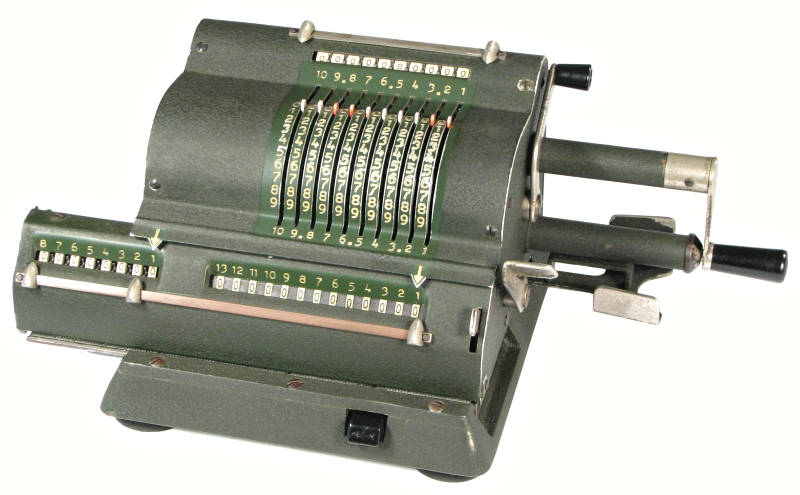 Multo Model 3, S/N 8145
Multo Model 3, S/N 8145
For details of Multo pinwheel calculators, please visit the
Addo and Multo page.
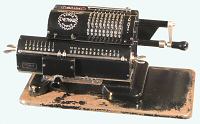 Felix calculator, S/N E55844
Felix calculator, S/N E55844
Digits: 9 rotor, 8 counter, 13 accumulator
Dimensions: Body 160W x 110D x 130H, overall width 330mm
Weight: 5.8 kg
Manufactured: Kursk, Russia
The "Felix" calculator is said to be named after Felix Dzerzhinsky, who established the Soviet calculator factory in Moscow in 1924, and later achieved fame as the founder of the KGB.
The machine illustrated has a cast-iron base and frame, with a sheet-metal carrying case. The mechanism and the internal construction are rather basic, but the machine is quite well-built and is still in good working order.
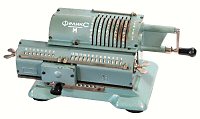 Felix calculator, Model M, S/N E215979
Felix calculator, Model M, S/N E215979
Digits: 9 rotor, 8 counter, 13 accumulator
Dimensions: Body 160W x 155D x 130H, overall width 320mm
Weight: 3.6 kg
Manufactured: Russia
A later version of the Felix, using light-alloy castings and weighting only 3.6kg.
 Tiger Calculating Machine, S/N 18084
Tiger Calculating Machine, S/N 18084
Digits: 9 rotor, 8 counter, 14 accumulator
Dimensions: Body 180W x 150D x 110H, overall width 290mm
Weight: 5.8 kg
Manufactured: Osaka, Japan, 1937
The Tiger Calculating Machine Co. Ltd. of Osaka was established in 1923, and became the largest of the Japanese mechanical calculator companies.
The machine illustrated dates from 1937. It is a conventional pinwheel machine, which is solidly built of cast iron and brass. The nine pinwheels are 49mm in diameter, with the setting levers spaced 6mm apart. A quick-clearing lever is located to the left of the setting levers.
The accumulator has 14 places, but the tens-carry only extends to 13. There is no tens-carry on the counter register. The carriage shift and clearing mechanisms are similar to the Trinks Brunsviga.
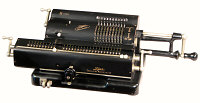 Tiger Calculating Machine, S/N 144060
Tiger Calculating Machine, S/N 144060
Digits: 10 rotor, 10 counter, 20 accumulator
Dimensions: Body 235W x 165D x 130H, overall width 430mm
Weight: 5.8 kg
Manufactured: Osaka, Japan, 1957
This Tiger machine dates from 1957, although the case design is largely unchanged from the 1930s. The mechanism uses a modified pinwheel with an extending gear segment instead of individual pins on the rotor, similar to that developed by Carl Friden at Marchant around 1920. The setting levers do not move as the rotor turns, but cause the gear segment to extend and retract at the appropriate times to advance the register by the required number of positions.
The Tiger calculator is very solidly built. The mechanism includes a setting check dial and quick-clearing lever, a wide carriage with a 20-digit accumulator, and a back-transfer mechanism operated by the small handle at the front left-hand corner of the baseplate. The counter register has manual reversing for division, and an odometer-style tens-carry mechanism which extends only to four places.
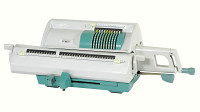 Tiger Calculating Machine, Model H68-21, S/N 429046
Tiger Calculating Machine, Model H68-21, S/N 429046
Digits: 10 rotor, 11 counter, 21 accumulator
Dimensions: Body 235W x 165D x 140H, overall width 450mm
Weight: 4.7 kg
Manufactured: Osaka, Japan, 1968
Model H68-21, first introduced in 1968, was the last of Tiger's mechanical calculators. Altogether, the company built almost half a million machines between 1923 and the closure of the calculator business in 1974.
The present machine is nicely built with an attractive two-tone plastic casing, and is a kilogram lighter than the models above. The mechanism has a number of changes and improvements over the earlier models. It still uses Friden's extending-segment principle, but with the gear segments and setting levers made of plastic instead of metal. The lever to clear the pinwheel setting is now conveniently located next to the winding handle. The carriage registers each have one additional place, and the counter register now has automatic reversing and full tens-carry. The counter carry uses an odometer-style mechanism with a set of four cam-operated levers which rise in sequence to assist the dials into their detent positions.
Internal view showing counter reversing and carry assist mechanisms.
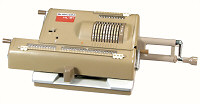 Busicom Model HL-21, S/N 331499
Busicom Model HL-21, S/N 331499
Digits: 10 rotor, 11 counter, 21 accumulator
Dimensions: Body 205W x 165D x 135H, overall width 410mm
Weight: 5.0 kg
Manufactured: Japan, late 1960s
Busicom, or the Nippon Calculating Machine Corporation, was established in 1928 by former staff from the Tiger company. In 1969 Busicom commissioned a small American company called Intel to make a chipset for a new electronic calculator. Rather than designing a custom calculator chipset, Intel designed a general-purpose processor that could be programmed to act like a calculator, under the control of instructions stored in a read-only memory (ROM). Intel re-purchased the rights to the design, and the world's first microprocessor - the 4004 - was released to industry in 1971. Had the customer been a little more commercially astute, we might all have been using Busicom computers today!
The Busicom HL-21 from the 1960s is a full-featured mechanical calculator with a setting check dial, back-transfer mechanism, and a 21-digit accumulator. The setting levers are only 5.5mm apart. The 11-digit counter register has full tens transmission, implemented using a miniature version of the pinwheel carry mechanism on the main rotor.